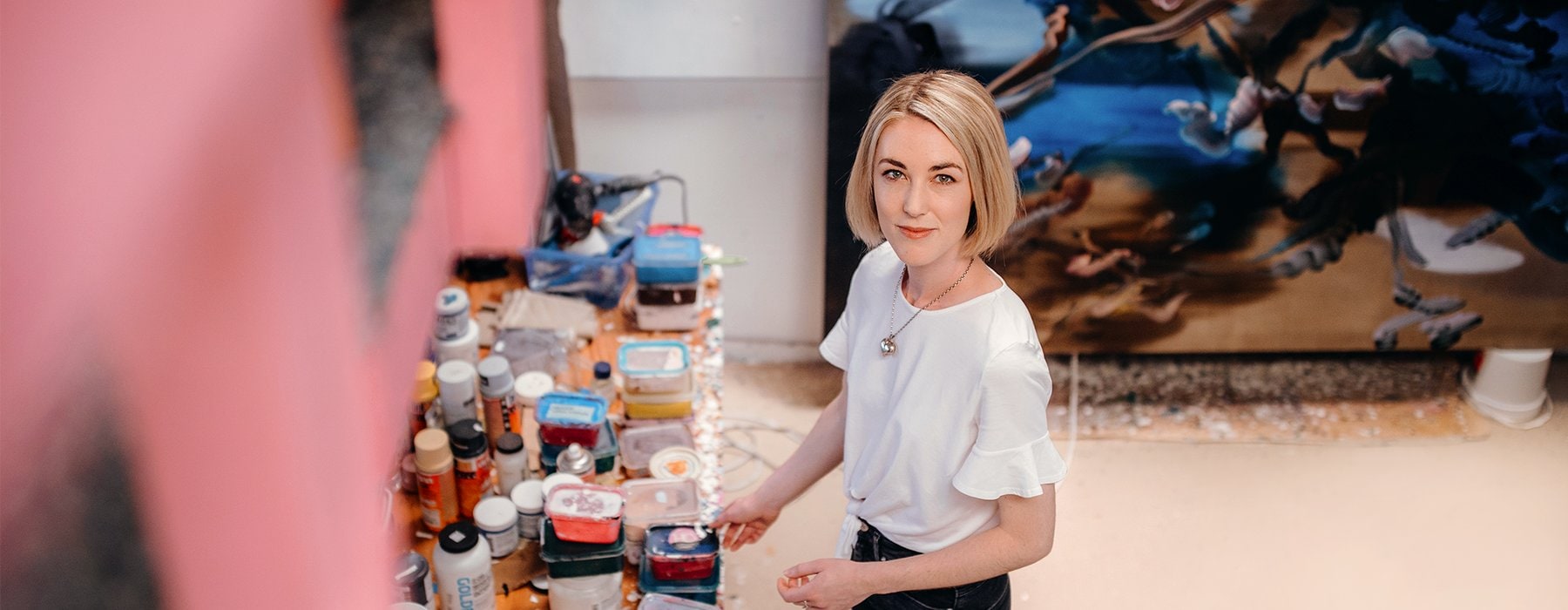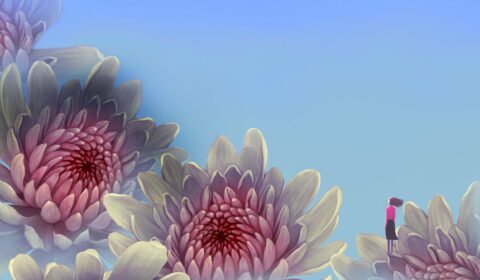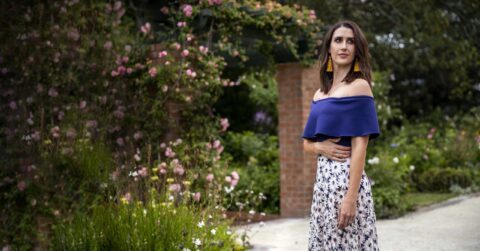Painter Grace Wright’s canvasses are full of expression and movement, and the art world is taking notice. She talks to Dionne Christian about her creative journey.
Look out the narrow window that runs the width of artist Grace Wright’s loft-like studio and you might mistake the outlook for a coastal setting – tall trees against a blue background create an illusion of sun and sea. But the reality could not be more different.
Rather, the studio is in a cavernous former factory divided into storage units and, on the upper floor, a rabbit warren of spaces shared by other artists. The building is in an Auckland city fringe suburb, where squat brick houses on one side of the street face small manufacturing businesses on the other, the road between blanketed in a red snow of falling pōhutukawa blossoms.
More industrial workshop than stark cube, Grace’s studio houses a trestle table with dozens of paint tins sitting neatly upon it, as well as a tiny notepad brought back in 2014 from the Uffizi Gallery in Florence, Italy, by her late and beloved grandmother Shirley Screech. It’s in impeccable condition and has become something of a talisman to Grace, who finds the colours in the cover painting, a detail from Botticelli’s Primavera, inspiring. Then again, it’s also a reminder of the enduring power of painting.
On another trestle table, Grace hand-stretches Belgium linen onto cedar bars, which become the canvasses she leans against a concrete wall to work on, allowing her to stand back and examine her progress. Her apron from the University of Auckland’s Elam School of Fine Arts, covered in paint splatters and brush wipings, hangs opposite.
It is from this unprepossessing setting that Grace, 28, is producing some of the most exciting painting seen in New Zealand in recent years. In 2020, amid Covid-19 and lockdowns, top dealer gallery Gow Langsford announced Grace was joining its strong stable, which includes some of the best artists in the country: John Pule, Max Gimblett, Dick Frizzell, Jacqueline Fahey and Judy Millar.

PHOTO BY EMILY CHALK
Gow Langsford has followed Grace’s career for several years, since she graduated from Elam in 2014 and began to clock up accolades and awards, including finalist placings in the 2015 and 2016 New Zealand Painting and Printmaking Awards, in the 2015 Molly Morpeth Canaday Art Award, and second runner-up at the 2019 Wallace Art Awards.
Gow Langsford co-director Anna Jackson says they were struck by Grace’s professionalism and the quality of her execution, but what impressed them most was the development of her practice in a relatively short period of time.
“With each new body of work her style continues to develop, she is constantly challenging herself and reimagining the limits of her practice,” says Anna. “We’re really excited by this potential and are confident she will emerge as a significant painter of her generation.”
Large, richly coloured, abstract, gestural and representational, Grace’s paintings draw on nature’s rising and falling rhythms, as well as the Baroque religious art of the 17th century and ideas about the body. The sheer size, coupled with the swirling shapes and colours within them, means you can’t help but think about how they were painted.

PHOTO BY EMILY CHALK
“The gestures themselves, I see as like proxy for bodies,” explains Grace, who was born and raised in Tauranga. “In historical works, where there’s a cluster of bodies reaching up to heaven and muscular forms and fleshiness – that’s kind of what those gestures are almost a stand-in for, so you read it at first as abstract, but you can almost see them as being bodies in a landscape.
“But there’s also the physical act of painting and that’s where the scale comes in. There’s a rhythmic kind of ‘bodiliness’ in the gestures and the way they’re painted. You can imagine the body moving around to create the marks. The paintings are often body-sized so they relate to your own body by being as big as you or bigger.
“I want the paintings to be a memorable experience; that you’re in a room with them but they just communicate quietly the sense of being so that you have a real experience and come away feeling good,” Grace continues. “I think in this crazy world, that’s so important; the experience of something you can’t just get from Instagram that kind of forces you to slow down and have an authentic – and I know it sounds cheesy – moment with them.”

PHOTO BY EMILY CHALK
Art lovers can judge for themselves at the Auckland Art Fair (February 24-28), where Grace’s paintings will be displayed at the Gow Langsford booth. She’ll then turn her attention to finishing off work for a solo show at Sydney’s Gallery 9 – still no word on whether she’ll be able to travel there – before working toward a second show at Gow Langsford in April.
“Beyond April, there’s nothing else planned, but it’s amazing how quickly things come up,” says Grace. “It’s funny, it always seems to work out just right, but it can be nice to have a few gaps.”
That might allow her time to pursue other interests. One of three sisters from a musical family, she plays bass guitar in a band with sister Holly, an engineer. Grace studied piano up to performance diploma level before giving it up, because two hours of daily practice did not leave enough time for painting. She’d earlier stopped contemporary dance lessons, but has since returned to it – saying she’s not very good and it’s just for exercise.
In any event, it’s not hard to see where the rhythm in her painting comes from, and that’s what Grace wants to devote herself to. Up until her fourth and final year of undergraduate study, Grace thought she’d be a graphic designer – after all, stories abound about how difficult it is to make a living as an artist.

“I was working as a freelance graphic designer for a company and doing freelance work for the university, just making posters for events and things like that, and it was around the fourth year when I could suddenly see the scope in my work and realised I didn’t want to be a designer,” she says. “I liked it, but I didn’t love it as much as I love painting – that’s the one thing I love to do most.”
During her honours year at Elam, Grace achieved the sort of breakthrough artists need to convince them to stay on the road less travelled. She was looking at images of the body and abstracting them into a series of coloured shapes, when a lecturer advised her to let go and, rather than work from images, paint a “sense of the body”.
“Suddenly, these coiling gestures came out, these curving, organic sort of gestural marks and it was probably around that point it felt like there was potential that could go beyond study; that it had scope to go further and it was its own language, in a way,” Grace tells. “It’s a really hard thing in art to have your own visual language.”
Those coiling gestures, painted initially in more candy-coloured hues, quickly became a signature of Grace’s work and were on colossal display when Parlour Projects, then a new contemporary art gallery in Hawke’s Bay, chose her as the first recipient of its artist-in-residency programme. Grace painted on the gallery’s main viewing wall, which meant creating a work that spanned 11mx6m, with the public invited to pop in and see her in action. Looking back, she describes it as “brilliant but also scary”, because she had just two weeks to paint it and, standing on the scaffolding to reach the top of the wall, she discovered an ever-so-slight fear of heights.
She also learned she prefers to paint alone, likening the process as going into a “flow state”, unaware of time and responding only to what is on the linen in front of her, making snap decisions about what to put the next mark or place the brush.
“I was telling a group of painters that I feel like I’m just trying to push myself right to the very edge of the painting failing and it all just being a big mess but, at the last minute, just pulling back, and there might be some final gesture or some last bit of painting that just makes it click.”
That sense of self belief comes back to developing a strong mindset, something Grace says she learnt from one of her early employers, who told her that the way you think determines how you will see your success – or otherwise.
“I love talking about this because I think it’s really important for people in whatever they’re choosing to do; to see the whole thing as a process and to trust in themselves,” Grace says. “At the end of the day, I just want to be a good painter. I love being here and making the work; it’s really simple, but I have to trust everything else will fall into place. Even when I had no shows or anything, I had to believe I was capable of being a good painter, that it was just going to be a journey – that’s how it’s been.”
Grace acknowledges turning down offers other emerging artists might have accepted, because she felt it would distract too much from her painting. She’s been asked about making limited edition prints of her work but has declined, saying each artwork is so different and she doesn’t want them replicated.
“Because it’s quite attractive, I think it could be made into a decoration but I think it’s deeper than that,” she explains. “It’s about having an authentic experience with the painting because that’s unusual in today’s overly saturated image world.”
She works part-time at Te Tuhi art gallery in Auckland’s Pakuranga and, from 2018-2019, combined this with painting and further study to complete her Masters of Fine Arts at Elam, something she believes has added to her own style of painting. It would not have suited Grace to do additional study straight from undergraduate level, because she acknowledges she needed time to evolve, make art and to have exhibitions.

PHOTO BY EMILY CHALK
Her MFA involved studying female artists, including Hilma af Klint, who was born in Sweden in 1862 and may well have been one of the first European abstract artists – had she not kept this revolutionary style to herself, convinced the world would not understand her work.
“I have always admired female artists who break out of the conventions that they grew up in, and I was interested in the idea of spirituality in art; how art can enable some sort of spiritual experience,” says Grace. “I was really interested in the way that in history, for male and female artists, spirituality was often the driver for their work. They felt like the work came through them and they would attribute that to some force of nature. It was, I think, a really enriching part of their work in painting and making art, but while it was an intrinsic part of their work, it was often used to discredit the work of women artists.
“I read about how women were only ever seen as imitators who couldn’t have true original thoughts or ideas, and the way they were shut out of things like life drawing classes and had to draw botanicals. I’ve been interested in the way they just did it anyway, this rebellious spirit and how they still broke through that. I find that quite inspiring.”








